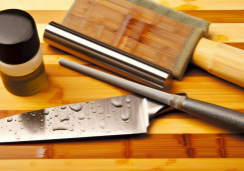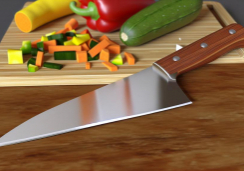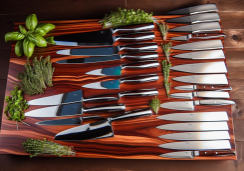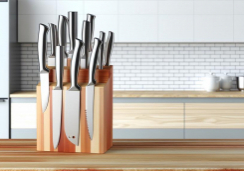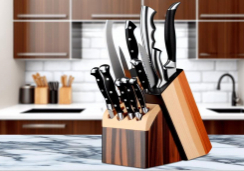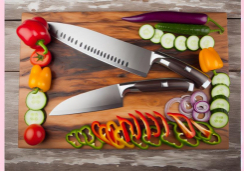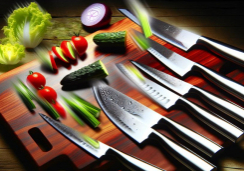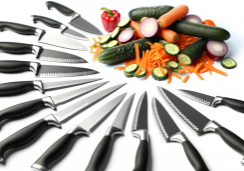Top Multipurpose Kitchen Knife Sets Reviewed
In your bustling, modern-day kitchen, a trusty set of knives is as indispensable as a suit of armor was to a medieval knight. You wouldn't joust with a wooden sword, so why settle for subpar blades when preparing your daily feasts? Slicing, dicing, and carving require precision and ease that only the finest utensils can provide.
As you stand in the culinary arena, you'll want to arm yourself with the best tools for the task. But with so many options on the market, how do you discern the worthy contenders from the dull impostors? Stay with me as I cut through the clutter and share insights on the top multipurpose kitchen knife sets that could elevate your food preparation to the level of artistry.
Essential Knife Types Explained
Understanding the different types of knives in a set can significantly enhance your culinary efficiency and precision. A chef's knife is your go-to tool for most tasks. With its broad and sharp blade, it's ideal for chopping, slicing, and mincing a variety of ingredients. It's the workhorse of the kitchen, versatile enough to handle most cutting jobs.
You'll also find a paring knife indispensable for more delicate work. Its small, pointed blade is perfect for peeling fruits and vegetables, hulling strawberries, or performing precise cuts.
When it's time to slice bread, a serrated knife is your best friend. The saw-like blade cuts through crusts without crushing the bread.
A utility knife bridges the gap between a chef's knife and a paring knife. It's great for tasks that are too small for the chef's knife but too large for the paring knife, like slicing sandwiches or cutting larger vegetables.
Lastly, a boning knife, with its thin, flexible blade, is designed to remove meat from bones with precision.
Each knife serves a distinct purpose, and knowing when to use which knife can greatly improve your cooking skills. A well-equipped set provides the necessary tools for a wide range of tasks, ensuring you're always prepared in the kitchen.
Knife Set Material Advantages
While each knife type in a set is designed for specific tasks, the materials they're made from can significantly affect their performance and longevity. You'll find that stainless steel knives are renowned for their rust resistance and ease of maintenance. They won't discolor or corrode easily, making them a practical choice for busy kitchens.
On the other hand, carbon steel knives are prized for their extreme sharpness and edge retention. However, they require more care to prevent rust and staining. If you're willing to invest a little extra time in maintenance, they can provide unparalleled cutting precision.
Ceramic knives offer a lightweight alternative with impressive edge retention, but they can be brittle and prone to chipping if not handled carefully. They're ideal for slicing fruits and vegetables but may not be the best choice for more robust tasks.
Finally, Damascus steel knives aren't only striking in appearance but also offer a combination of durability and edge retention, thanks to their layered construction. They can be more expensive, but for many, the investment is worth it for both performance and aesthetics.
Choosing the right material for your knife set depends on your cooking style, maintenance preferences, and budget. Each material has its own set of advantages that can enhance your culinary experience.
Handle Design and Ergonomics
The handle of a kitchen knife is as crucial as the blade, playing a key role in comfort and control during food preparation. When you're chopping, slicing, or dicing, the handle is your main point of contact with the knife. It's important that it feels comfortable in your hand and doesn't cause fatigue or discomfort, even with prolonged use.
Ergonomic handle design aims to provide you with a natural grip that aligns with the movement of your hands and wrists. Look for handles that are contoured to fit the curves of your palm, offering a secure grip even when wet. Materials also matter; options like rubber provide a non-slip surface while wood can offer a warm, classic feel but may require more maintenance.
Balance is another critical factor— the handle should counterbalance the blade to make the knife feel almost weightless in your hand. This balance helps in precise cutting and reduces the strain on your wrist.
Ultimately, a well-designed handle contributes to the knife's overall performance. It should encourage correct hand placement and movement, reducing the risk of injury. Remember, no matter how sharp a knife's blade may be, it's the handle design and ergonomics that will dictate your comfort and control in the kitchen.
Maintenance and Care Tips
Having discussed the importance of handle design for comfort and control, let's now focus on how to keep your kitchen knives in top condition through proper maintenance and care.
Firstly, always hand-wash your knives with mild soap and warm water. Dishwashers can cause knives to bump against other items, dulling the edge and damaging the handle. Dry them immediately to prevent rusting. Store knives in a block or on a magnetic strip to avoid blade damage that can occur in a cluttered drawer.
Honing and sharpening are both essential. Honing realigns the knife's edge, keeping it sharp between more intensive sharpenings. Use a honing steel every few uses, but don't confuse this with sharpening, which removes metal from the blade to create a new edge. This is needed less frequently, depending on usage—perhaps every six months or annually.
Lastly, use cutting boards that are knife-friendly. Hard surfaces like glass or stone can quickly dull your blades. Opt for wood or plastic instead. And don't forget to cut with the proper technique; slicing rather than pushing down helps maintain the knife's edge.
Top 5 Knife Set Recommendations
Let's delve into our top picks for kitchen knife sets that balance quality, value, and versatility to enhance your culinary endeavors. You're sure to find a set that not only meets your needs but also complements your skill level and the aesthetics of your kitchen.
Here are the top 5 recommendations:
- Wüsthof Classic Ikon 7-Piece Walnut Block Knife Set
This set from Wüsthof offers a sturdy build and precision with high-carbon stainless steel blades. The ergonomic handles provide comfort, and the walnut block adds a touch of elegance to any countertop.
- Global 6-Piece Block Set
Global's distinctive design and cutting-edge technology are evident in this set. The knives are lightweight, yet balanced, with a unique, smooth design that's easy to clean.
- Shun Classic 6-Piece Slim Knife Block Set
Shun knives are renowned for their sharpness and beauty. This set features VG-MAX steel blades with 34 layers of stainless Damascus cladding on each side.
- Zwilling J.A. Henckels Twin Signature 7-Piece Knife Block Set
Zwilling J.A. Henckels offers a durable set with ice-hardened, high-carbon stainless steel blades that are hand-honed for sharpness.
Choose wisely and remember that the best knife set is one that fits seamlessly into the way you cook and care for your tools.
– How can High-Carbon Steel Knives be used as part of Multipurpose Kitchen Knife Sets?
High-carbon steel knives are a versatile addition to any kitchen knife set. Their durability and sharpness make them perfect for chopping, slicing, and dicing a variety of ingredients. To keep these knives in top condition, it’s essential to follow a proper highcarbon steel knife maintenance tutorial to prevent rust and maintain their edge.
Conclusion
You've learned about essential knife types, materials, handle ergonomics, and maintenance.
Whether you choose a set with carbon steel for precision or stainless steel for durability, remember that balanced handles and a comfortable grip are key for long cooking sessions.
Keep them sharp and clean, and they'll serve you well.
From the top 5 sets reviewed, select what fits your culinary needs and budget.
Invest wisely, and your kitchen endeavors will be as enjoyable as they're efficient.

